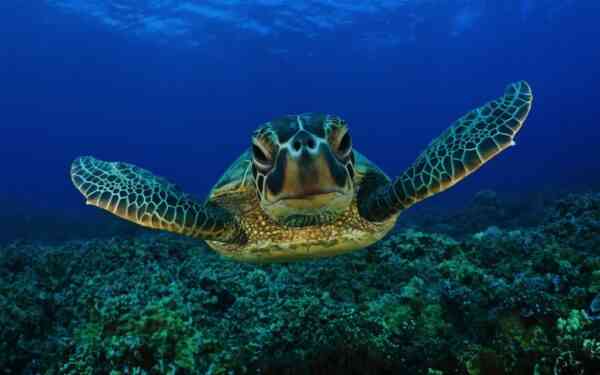Sea turtles are the largest representatives of these amazing creatures, chained in strong bone shells. They live in a variety of seas and oceans, earn their livelihood in different ways, but they all suffer equally from human activity. Despite the fact that in many countries these animals are protected by law, they are still aggressively hunted.
Interesting facts about sea turtles
- Their shells are flatter than those of terrestrial turtles and are teardrop shaped. Nature created them so that it was easier for them to cut through the water column.
- Sea turtles cannot retract either their head or flippers into the shell.
- Almost all species of sea turtles are noticeably larger their terrestrial relatives (interesting facts about turtles).
- The largest of them are the so-called green ones. Their shell can be up to 1.4 meters long, but even in the smallest species of sea turtles it can be 60-65 centimeters.
- In one breeding season, females sometimes lay up to 1000 eggs. But they are often eaten by predators and collected by humans, and baby turtles are often eaten by birds and fish shortly after birth.
- In ancient Malaysian mythology, it is the sea turtle that is the creator of the world.
- Some and the same species of sea turtles living in similar conditions, but in different regions, lay eggs at different times.
- They all live only in warm tropical and subtropical waters.
- Sometimes sea turtles swim many thousands of kilometers during the breeding season to get to a suitable place where they lay their eggs.
- The weight of the largest sea turtles, green ones, can reach 400 kg.
- The first sea and ocean turtles appeared on Earth more than 100 million years ago.
- Clumsy on the shore, in the water, these animals are capable of developing significant speeds, up to 30 -35 km/h
- The leatherback sea turtle is the only one that does not have a bony shell at all.
- When they swim, only powerful front legs are used in the process, with which the turtle rows like flippers.
- Sea turtles always return to lay their eggs in the place where they themselves were born. They always find their way to it and do not forget it even after many decades.
- They often live up to 70-80 years, but there have been cases of life expectancy over 100 years.
- During migration, sea turtles unmistakably overcome great distances, orienting themselves, like birds, by the magnetic field of our planet (interesting facts about birds).
- Having laid their eggs, they forget about them forever, and do not care about their offspring.
- In general, about 1% of their cubs survive. The rest are eaten by predators in the very first hours after they get out of the eggs.
- For the first 3-5 years of life, baby sea turtles feed mainly on plankton and various small sea creatures, but, having matured, they become vegetarians, and in the future, only plants are eaten.
